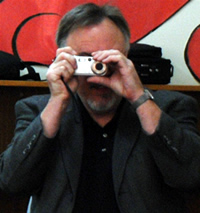
First day with Warlick
 Well we’re through the first day of David Warlick’s visit. He did three sessions on Harnessing the Digital Landscape with our teachers and one Video Games in education….and today is a light day for him. When we bring speakers in..which isn’t very often, we tend to have them going full on and David is no exception.
Well we’re through the first day of David Warlick’s visit. He did three sessions on Harnessing the Digital Landscape with our teachers and one Video Games in education….and today is a light day for him. When we bring speakers in..which isn’t very often, we tend to have them going full on and David is no exception.
One thing that struck me today about David’s video gaming session was when he stated:
Bring the parts of a game that engages students into the classroom.
A classroom that is
responsive
conversable Rewards
personal investment
Identity Building
Dependability
Interesting….I’m looking at these five skills that students get from video games…then I look at the conversation around School 2.0….hhhhmmm.
Responsive=We want students to respond to information, we want them to engage information and not passively sit back while the information passes them by.
Conversable Rewards= We want them to have conversations, we want them to talk about information, to internalize it and hear other’s points of view on the subject.
Personal Investment= We want students to be intrinsically motivated. We want student to be invested in their own learning, to ‘want to learn’.
Identity Building= We want students to become individuals, to create their won identity. More than that we want to help them build a positive digital identity.
Dependability= We want students to be dependable to know that we can count on them when we need them, to be responsible and dependable for their own learning.
One could argue that these are not just skills in School 2.0 but rather are basic skills we would hope every students would have…and they are finding them, learning them, and using them in video games.
We talk about the disconnect between schools and the world our students know. Yet the skills we want students to have are being taught when they are disconnected from school and connected to their “learning environment” an interesting concept.
David and I talked for a while after the video game session on where video games fit in education. I just kept saying “We’re missing something” I just fill there is a piece of the puzzle that doesn’t quite fit yet. Maybe it’s just me, but the light bulb just isn’t all the way lit (no jokes please). I know they use games to learn, I understand what they do with them, the power that they hold….what is their role in education? How do they ‘fit’ into our schools….maybe that’s my problem, I’m trying to make video games ‘fit’ into a system that can not hold them, take advantage of them, or even wants too.
OK, to late…now my brain hurts and another full day tomorrow…for David not me. 🙂 4 more teacher sessions and then a parent presentation. There’s not much grass in Shanghai, because people don’t stand around enough to watch it grow under their feet…and David won’t be seeing much of it here either!
[tags]techfest, SAS[/tags]
Technorati Tags: Warlick, SAS, SASTechFest, sastechfest07







The very same, or at least remotely similar, questions came to my mind after reading about a program that is using some of these principles in current practice. Here is the link: http://spotlight.macfound.org/main/entry/pinkard_videogames_inspire_classroom_design/
The “Conversable” piece is crucial. I have been looking through my student wikis lately, focusing on the conversations that occur in the discussion boards. They are wrestling with each other in deciding what stays and what goes. That is ownership to me. So when it comes to how we fit in the elements of video games, I think this is part of it. I don’t profess to know how the whole picture fits in, but the pieces are usable on their own too.
RT @SetantaUS: We have an all new and improved television listings page for Setanta and Setanta-i. Check it out http://bit.ly/18njh